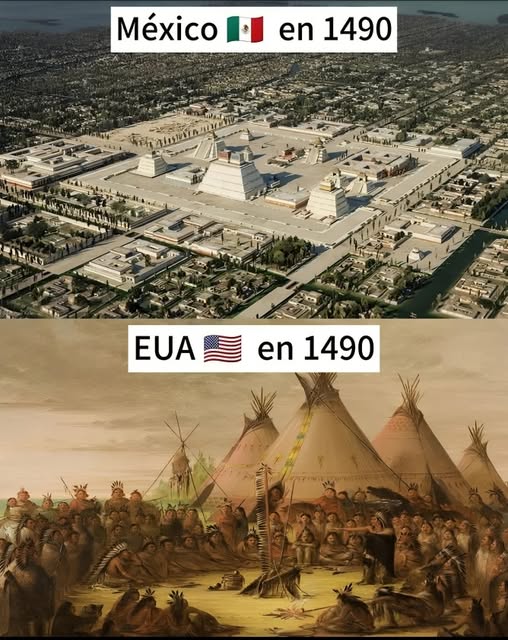🇲🇽 Tenochtitlán — A city of stone and water. In 1490, it thrived with canals, towering temples, vibrant marketplaces, and brilliant engineering—the heart of the Mexica (Aztec) empire, pulsing with culture and innovation.
🇺🇸 North America — A vast land of diverse tribal nations, each rich in wisdom, tradition, and deep harmony with nature. From the forests of the Iroquois to the plains of the Lakota, and the deserts of the Hopi—sophisticated societies thrived, each shaped by the land they honored.

🇲🇽 Tenochtitlán, 1490
In the heart of what is now Mexico City stood one of the most advanced urban centers in the world: Tenochtitlán, the jewel of the Mexica (Aztec) Empire.
This city wasn’t just large—it was visionary. Built on a lake, it was connected by an intricate network of canals, bridges, and causeways. It featured massive temples, sophisticated marketplaces, floating gardens (chinampas), and public sanitation systems that rivaled or surpassed those in Europe at the time.
Tenochtitlán was a place of art, astronomy, architecture, agriculture, and power—a living testament to the genius of Mesoamerican civilization.
🇺🇸 North America, 1490
To the north, the land was vast and diverse—a tapestry of thriving Indigenous nations with unique languages, governments, traditions, and technologies.
From the Haudenosaunee Confederacy (Iroquois) in the Northeast, who practiced democratic governance, to the Mississippian mound builders who created monumental earthworks, to the Ancestral Puebloans with their complex cliff dwellings and water systems in the Southwest—North America was rich in innovation, culture, and harmony with nature.
Across the plains, deserts, forests, and coasts, Indigenous peoples lived in deep connection with the Earth—guided by traditions that honored balance, kinship, and the sacredness of the land.
🪶 Two Worlds of Greatness — Before Colonization
In 1490, the Western Hemisphere wasn’t an “undiscovered” wilderness—it was a land of sophisticated civilizations. While European kingdoms fought over crowns and crusades, the people of this continent lived in advanced, spiritually rooted societies shaped by their landscapes and ancestors.
What colonization often erased, history must now remember.
✊🏽 Respect the Roots. Remember the Greatness.
These were not primitive people. They were philosophers, engineers, artists, scientists, and guardians of the Earth. The ruins still whisper. The stories still live.
Let us honor the civilizations that came before—with truth, reverence, and the commitment to tell their stories with the dignity they deserve.
Leave a Reply